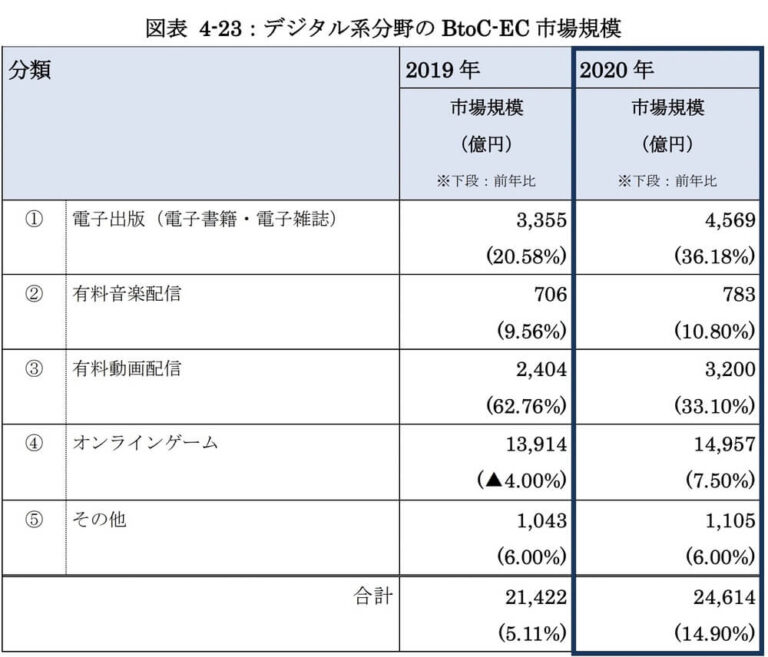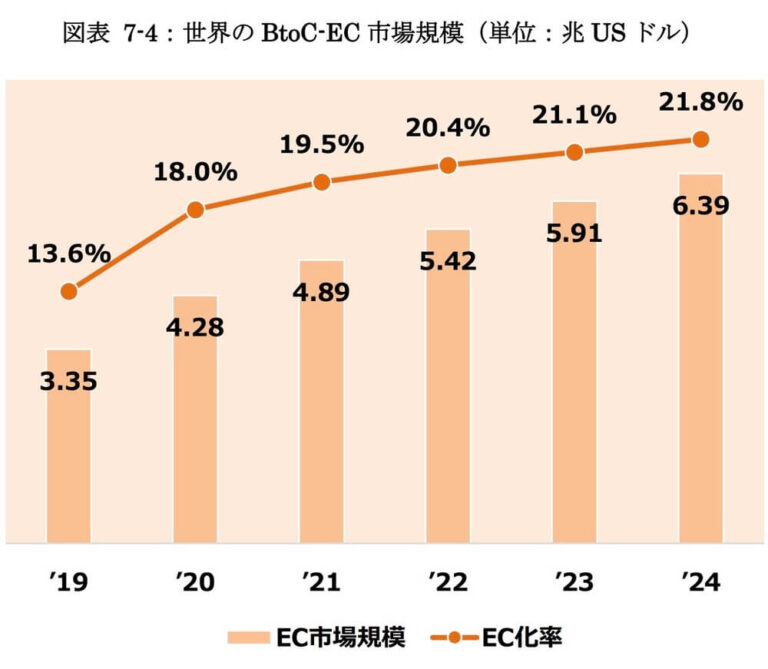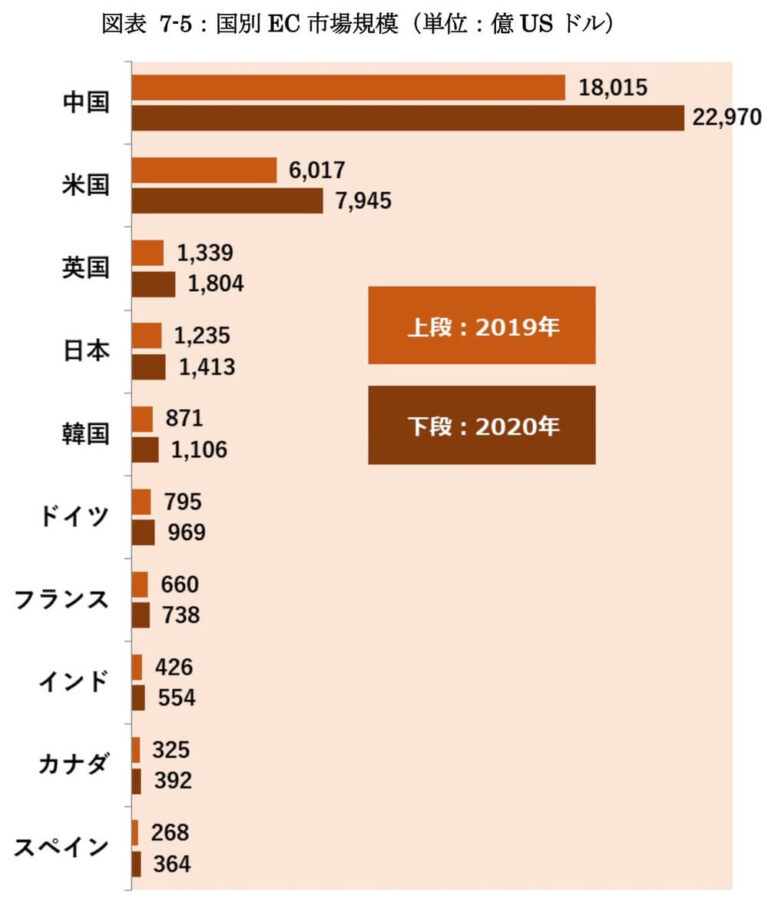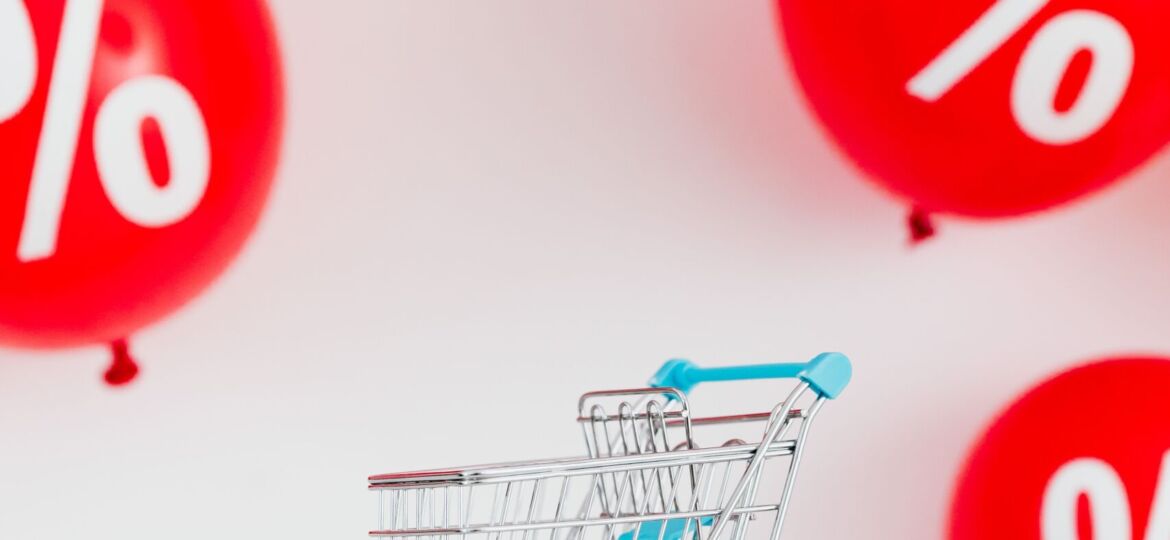
Explaining the differences between Japan and the world and future forecasts
The growth of the e-commerce sector has been remarkable in recent years, and it can be a promising market for many companies. Therefore, it is important to keep track of the trends in the EC market to consider entering the EC market and to predict the future of your company.
This article focuses on the EC conversion rate.
- Domestic EC conversion rate in Japan and its trends
- Detailed EC conversion rate by industry
- Comparison with the world’s EC conversion rate
Table of Content
What is the EC Conversion Rate?
EC Industry Market Size and EC Conversion Rate in Japan
BtoC: EC Market Size and EC Conversion Rate in the "Product Sales”
BtoC: EC Market Size and its Characteristics in the "Service Field”
BtoC: EC Market Size and its Characteristics in the "Digital Field"
Global E-commerce Rates and E-commerce Situation
Outlook and Forecast of Future EC Market and EC Conversion Rate
Points to keep in Mind When a Company Enters the EC Industry
Summary: The EC Rate is Growing Both Domestically and Globally!
What is the EC Conversion Rate?
The EC conversion rate refers to “the percentage of the EC (electronic commerce) market size to all commercial transactions.”
In other words, it is an indicator that shows “the percentage of products purchased through the Internet.
To make it easier to visualize, let’s apply a simple figure: the EC conversion rate can be calculated roughly as follows.
→ EC conversion rate = Total amount of EC ÷ Total amount of all commercial transactions
For example, in industry A, “the total amount of all commercial transactions is 10 billion yen”. This 10 billion yen is the total amount including all transactions such as store sales, face-to-face sales, telephone, fax, EC, etc.
And suppose that out of this 10 billion yen, “transactions using EC were 3 billion yen.” In this case, the EC ratio of industry A would be 30%.
→ EC conversion rate = total amount of EC (3 billion yen) ÷ total amount of all commercial transactions (10 billion yen) = 30%
By calculating in this way, it is possible to clarify “how much EC is used” for each industry and market.
In addition
- High EC rate = Active trading on the Internet (high need to use EC)
- Low EC rate = Trading on the Internet is not progressing (trading in actual stores is the mainstream)
Thus, knowing the EC rate can be a hint to grasping the actual state of the market. Therefore, it is important to check the EC rate of industries you are planning to enter or are involved in.
Let’s take a look at the actual “EC rate of each industry in Japan” next.
EC industry market size and EC conversion rate in Japan
The Ministry of Economy, Trade, and Industry (METI) has released the results of a survey on “Trends in the EC Industry” in Japan.
In the FY2020 “Market Survey on Electronic Commerce Transactions,” the following data was collected
In the ” Market Research on Electronic Commerce ” in Reiwa 2nd year,
- BtoC (transactions between companies and consumers)
- BtoB (transactions between businesses)
- CtoC (transactions between consumers)
The following is an overview of the EC market size and EC conversion rates in each of these three categories.
Each of them is introduced here one by one
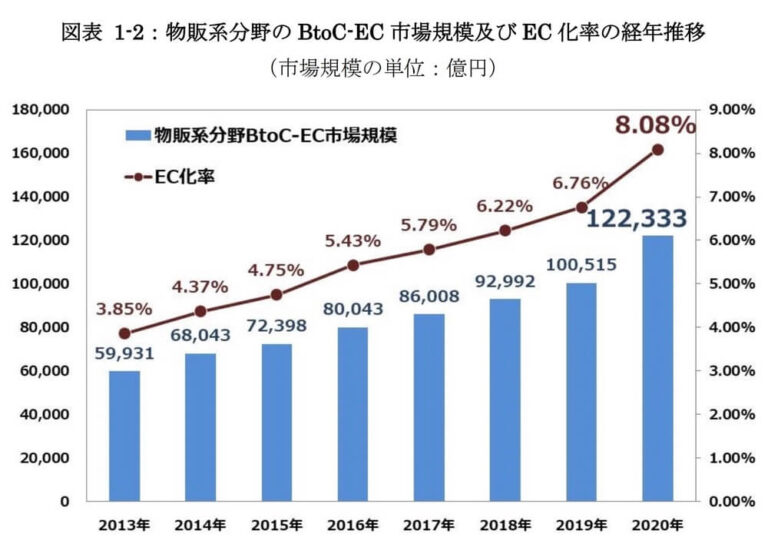
The EC conversion rate for BtoC (business-to-consumer) transactions was “8.08%*1” as of 2020. Looking at past trends, the EC conversion rate has increased by about 0.5 points every year from 2013 to 2019.
Most recently, however, it grew by 1.32 percentage points year on year, more than doubling at one point. This is due to the global expansion of the epidemic in 2020 and the rapid increase in the number of EC users completing their shopping at home.
In addition, the size of the BtoC EC market was
- Product sales (home appliances, clothing, food, etc.)
- Service-related fields (travel, restaurants, finance, etc.)
- Digital (electronic publishing, games, etc.)
The table below summarizes the BtoC EC market by dividing it into the following three categories.
2019 | 2020 | Growth rate | |
Product sales field | 10,051.5 billion yen (EC rate 6.76%) | 12,233.3 billion yen (EC rate 8.08%) | 21.71% |
Service field | 7,167.2 billion yen | 4,583.2 billion yen | ▲ 36.05% |
Digital field | 2,142.2 billion yen | 2,461.4 billion yen | 14.90% |
total | 19,360.9 billion yen | 19,277.9 billion yen | ▲ 0.43% |
* Quote: Ministry of Economy, Trade, and Industry ” Reiwa 2nd Year Industrial Economy Research Consignment Project (Market Research on Electronic Commerce) ” July 2021

The EC conversion rate for BtoB (business-to-business) was “33.5%” as of 2020.
The BtoC rate was 8.08% in the same year, so the figure is quite high by comparison. However, this 33.5% figure includes EDI (online processing of business-to-business forms).
Please note that it is calculated higher than the actual EC conversion rate because it is not calculated separately from general EC sites.
Nevertheless, the shift to EC is steadily advancing, with the appearance of EC services specialized for BtoB and the development of EC tools that are easy to operate and manage.
The following table summarizes the size of the BtoB EC market by industry sector.

The market size, which had been growing steadily, has shrunk in many areas by 2020. The background to this is the major changes in needs due to the coronavirus and the shift in business models.
However, e-commerce rates are growing in all sectors, resulting in an ever-increasing acceleration of online commerce. It is expected that EC will continue to be promoted in the future to develop new sales channels and improve the efficiency of ordering operations.

CtoC (consumer-to-consumer) transactions are not included in the EC conversion rate calculation because many of these transactions are conducted online.
As of 2020, it has become clear that the EC market size is 1,958.6 billion yen (a growth rate of 12.5%).
As a result of the flea market apps becoming widespread and the use of EC being recommended due to epidemic diseases, the number of CtoC users has increased rapidly.
Compared to other markets:
- BtoC was 19,277.9 billion yen in the same year
- BtoB was 334.9106 trillion yen in the same year
Although still small compared to other markets, CtoC is steadily growing, and its rise will continue to attract attention in the future.
BtoC: EC market size and EC conversion rate in the "product sales”
*Reference: Ministry of Economy, Trade and Industry, “FY2020 Industrial Economy Research Commission Project (Market Survey on Electronic Commerce),” July 2021.
In order of highest to lowest EC conversion rates, the following are the highest to lowest EC conversion rates
- 1st place: “Books, video/music software” 42.97%
- 2nd place: “Home appliances, AV equipment, PCs/peripherals, etc.” 37.45%
- 3rd place: “Household goods, furniture, interior goods” 26.03%.
The above three fields have been ranked in the top three even before the virus spread, and the EC rate is currently increasing. Among these goods sales-related fields, these are the fields that are most compatible with EC.
“Books, video and music software” is ranked first, with books being one of the most common items that users purchase in their daily lives. As a result, many business people conduct teleworking. This may be a reason for the increase in demand for books and DVDs, as well as for purchasing books online.
In second place are “household appliances, audio/visual equipment, PCs and peripherals, etc.” Originally, in this field, customers could nominate products by model number or product name, and the quality would not change no matter where they bought them. This is a good fit with EC, and the EC conversion rate is expected to grow in the future.
And in 3rd place are “life miscellaneous goods, furniture, interior” goods. This comes from spending more time at home due to the impact of COVID 19. There is increased telework from home and more demand for furniture and interior goods.
On the other hand, even with the spread of the pandemic, the EC conversion rate for “food, beverages, and alcoholic beverages” in 2020 was 3.31% (up 0.42 points from the previous year), showing no significant increase.
The reason is this is:
- Demand for fresh food products is such that shoppers prefer to pick them up in person.
- Time and shipping costs for delivery
- Physical stores are located nearby and are more convenient than e-commerce.
These factors are considered to be the main reasons for this trend.
As described above, food products are a very difficult field to be converted to EC. However, if logistics bases are developed and nationwide delivery becomes possible, the EC rate is expected to increase significantly.
BtoC: EC Market Size and its Characteristics in the "Service Field”

While the goods sales sector has steadily increased its EC rate, the three categories of “travel services,” “food and beverage services,” and “ticket sales” have been hit hard by the epidemic. This has resulted in an unprecedentedly large reduction in market size.
However, there is no doubt that these service-based sectors will recover to some extent once the infection subsides. This is because the need to travel and eat out is not itself decreasing significantly.
Commerce & Life conducted a “Survey on what people want to do after Corona settles,” the results were as follows.
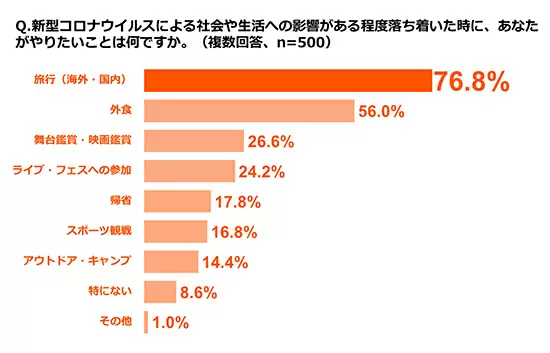
What they would like to do when the situation settles down is
- Travel 76.8%
- Eating out 56.0%
And, it is ranked overwhelmingly away from third place and below.
In terms of travel and restaurant services, there are increasing opportunities to make reservations online, and in the long run, the use of EC will recover.
BtoC: EC Market Size and its Characteristics in the "Digital Field"
Looking at the digital field as a whole
- “Electronic publishing” is 36.18%
- “Paid video distribution” is 33.10%
These two fields are growing significantly.
The widespread use of video distribution services and increased demand for entertainment at home have continued to result in significant growth in these areas.
In addition, the number of “member-only attractive original content” such as Amazon Prime and Netflix exclusive is increasing, and it is expected that the number of TV viewers will decrease accordingly.
In this way, 2020 has had a significant positive impact on the entire digital field.
*Reference: Ministry of Economy, Trade, and Industry, “FY2020 Industrial Economy Research Commission Project (Market Research on Electronic Commerce),” July 2021.
Three reasons why the EC rate is increasing overall
In Japan, the EC market size and the EC conversion rate are growing steadily as a whole.
There are three main reasons.
- Increased use of EC via smartphones
- The emergence of EC tools that are easy to operate and manage
- Increase in demand due to epidemic
Let’s look at each one.
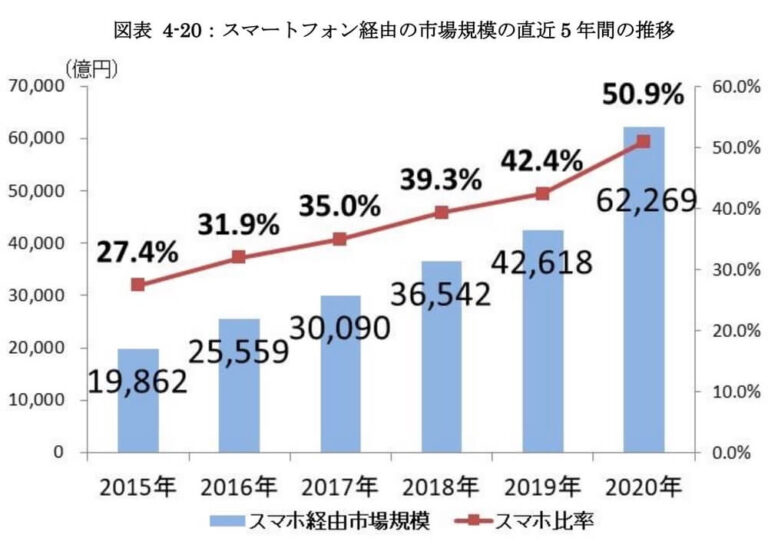
There is no doubt that the increase in demand for EC via smartphones is one of the reasons for the increase in the EC conversion rate.
Rather than booting up a computer, searching for the product you want, entering order information, and making payment, it is far less difficult to purchase a product on your smartphone at any time you want, with your smartphone at your fingertips.
In addition, many people are interested in buying products (fashion, cosmetics, etc.) recommended by influencers, and the use of EC is expected to increase further, especially among younger consumers.
As the number of EC users is increasing, the number of tools and systems that support EC businesses is increasing year by year.
For example, in the past, when purchasing products on a business’s own EC site, payment information had to be entered from scratch.
However, if the system can be linked to an Amazon account, the purchase can be made smoothly without such a hassle. As a result, the basket drop rate will be reduced, making it easier to increase sales.
In addition, EC tools that are easy to use are now available to make it easier for businesses with little technical knowledge to start EC.
In this way
- Tools that support sales expansion and operational efficiency
- Tools that are easy to operate and manage
It is also a factor of the increase in the EC conversion rate that it became easier to proceed with the business.
The epidemic of epidemics in early 2020 drastically changed our lifestyle over the long term.
While overall growth may slow as the situation settles down, growth is expected to continue to expand in the future as we have been able to incorporate many segments of the population that had previously shunned EC.
Global E-commerce Rates and E-commerce Situation
*Reference: Ministry of Economy, Trade and Industry, “FY2020 Industrial Economy Research Commission Project (Market Research on Electronic Commerce),” July 2021.
Next, let’s take a look at the global EC conversion rate.
According to the market research of the Ministry of Economy, Trade, and Industry, the EC conversion rate including the BtoC market of the whole world is “18.0%” in 2020, and it is expected to grow by about 1 point in the future.
Since the EC rate for Japan’s BtoC market is 8.08%, it is clear that the EC rate in Japan is low compared to the world as a whole.
However, the size of the Japanese e-commerce market is by no means small. Let’s look at the size of the EC market by country.
As shown in the graph, China and the U.S. have the largest EC markets in the world, with Japan in fourth place.
Why are the EC markets in China and the U.S. so large?
- The countries have large populations.
- The country is large, and shopping in a physical store takes time.
- The infrastructure for EC is well developed.
These main reasons for the growth of the EC market in the U.S.
Especially in China, the view that “online payment is more reliable and safer than cash” is widespread, and there are many cases where only smartphone payments and QR code payments can be made at stalls.
In this way, China’s unique circumstances have also helped, and as a result, e-commerce is advancing at a top level in China, even by global standards.
Keep in mind that it is difficult to compare Japan with China / the United States because the situation is very different in Japan.
*Reference: Ministry of Economy, Trade and Industry, “FY2020 Industrial Economy Research Commission Project (Market Research on Electronic Commerce),” July 2021.
Outlook and forecast of future EC market and EC conversion rate
The use of EC via smartphones is increasing year by year, and “I’m too scared to buy online” is a long time ago. In addition, for businesses, EC is more cost-effective than physical stores, and tools that are easier to operate and manage are increasingly being introduced.
Social issues such as population decline and regional depopulation are expected to increase the number of businesses entering the EC market as a new sales channel expansion. Thus, from the perspective of both users and businesses, the EC market is expected to continue to expand in size and the EC rate is expected to grow
However, there are major logistics issues, such as the burden of delivery charges and the shortage of courier companies. From this point of view, there are cases where the actual store is stronger.
Nevertheless, improvements in logistics have been steadily progressing in recent years, as evidenced by the testing of drone delivery and the gradual spread of delivery by drop-off and pick-up
If logistics problems can be solved one by one, delivery costs will decrease and the EC market will expand further.
Points to keep in mind when a company enters the EC industry
Then, what points should we be careful about when starting an EC business?
There are various points to keep in mind, but one of the most important is “clarifying the purpose of the EC business. If the purpose is ambiguous or unclear, the strategy to be taken will also be ambiguous, and the desired results will not be achieved.
Therefore, it is recommended that you first clarify what you want to achieve and what you want to achieve through the EC business, and then calculate back from there to consider the construction and operation of the EC site.
Summary: The EC rate is growing both domestically and globally!
Here is a summary of the points in this article again.
- EC conversion rate is an indicator that shows “the percentage of products purchased through the Internet
- In 2020, the EC rate for BtoC is “8.08%” and the EC rate for BtoB “is 33.5%”
- The reason why the EC rate is growing every year is the spread of smartphones and the emergence of convenient EC tools.
- Although the EC conversion rate is lower than that of China and the United States, it cannot be compared in general.
- When entering the EC market, it is essential to “clarify the purpose of the EC business
There are various pitfalls in launching EC, and many companies are struggling to achieve results. Check out our other articles on EC to ensure you are prepared.





